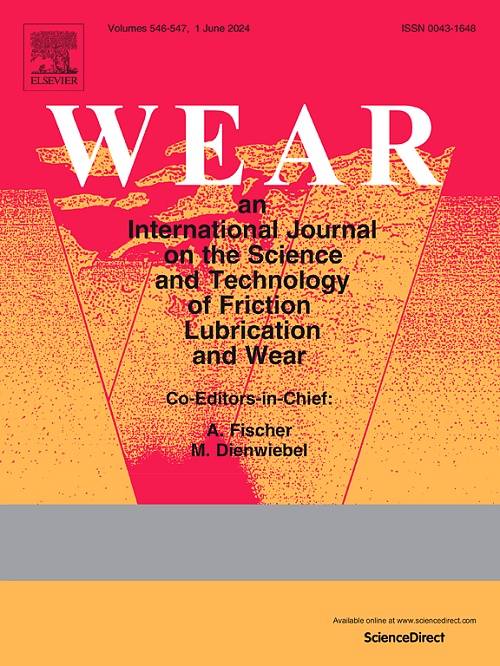Experimental quantification of the wear performance of rolls used in industrial rotary straightening of seamless steel tubes
IF 6.1
1区 工程技术
Q1 ENGINEERING, MECHANICAL
引用次数: 0
Abstract
Gaining detailed information about the wear performance of work rolls used for rotary straightening of seamless steel tubes is of utmost importance for extending the service life and, thus, for reducing costs and maintenance efforts. However, comparing the wear performance of different work rolls after their use in industrial straightening machines is almost impossible, as roll materials, service conditions and production portfolios are usually quite different. Therefore, this experimental study investigates the wear of two roll materials (high-chromium cast iron, HCCI, and modified cast high-speed steel, HSS) under rolling/sliding contact with selected tube steels (grades L80 and Q125) by using a two-roll test rig. The materials were tested at specified constant contact force, temperature and roll slip to simulate the complex conditions of an industrial straightening process. After each of the test runs the weight loss of the test roll was measured using a precision scale, and the volume loss was captured using an optical 3D geometry scanner. Over the rolling distance or rolling time, respectively, a virtually linear weight/volume loss was observed for steady-state wear beyond the initial run-in phase, which enabled calculating the material-specific wear coefficients of HCCI and HSS for the particular testing conditions. Very similar wear coefficients were determined for both materials, as the microstructure (carbides) and thus the bulk hardness of HCCI and of modified HSS were similar. The specific wear coefficients enabled estimating the service life of industrial work rolls as function of the grade and of the dimension of the straightened steel tubes.
工业用无缝钢管旋转矫直辊磨损性能的实验量化
获得关于用于无缝钢管旋转矫直的工作辊磨损性能的详细信息,对于延长使用寿命,从而降低成本和维护工作至关重要。然而,由于轧辊的材料、使用条件和生产组合通常有很大的不同,在工业矫直机中使用后,对不同工作辊的磨损性能进行比较几乎是不可能的。因此,本实验研究利用双辊试验台研究了两种轧辊材料(高铬铸铁,HCCI和改性铸造高速钢,HSS)在与选定管材(牌号L80和Q125)滚动/滑动接触下的磨损。在给定的恒定接触力、温度和辊滑移条件下对材料进行了测试,以模拟工业矫直过程的复杂条件。在每次测试运行后,测试辊的重量损失使用精密秤测量,体积损失使用光学3D几何扫描仪捕获。在轧制距离或轧制时间内,在初始磨合阶段之后的稳态磨损中,观察到的重量/体积损失几乎是线性的,这使得计算特定测试条件下HCCI和HSS的材料特定磨损系数成为可能。两种材料的磨损系数非常相似,因为微观结构(碳化物)和HCCI和改性HSS的体硬度相似。特定的磨损系数可以估计工业工作辊的使用寿命,作为矫直钢管等级和尺寸的函数。
本文章由计算机程序翻译,如有差异,请以英文原文为准。
求助全文
约1分钟内获得全文
求助全文
来源期刊

Wear
工程技术-材料科学:综合
CiteScore
8.80
自引率
8.00%
发文量
280
审稿时长
47 days
期刊介绍:
Wear journal is dedicated to the advancement of basic and applied knowledge concerning the nature of wear of materials. Broadly, topics of interest range from development of fundamental understanding of the mechanisms of wear to innovative solutions to practical engineering problems. Authors of experimental studies are expected to comment on the repeatability of the data, and whenever possible, conduct multiple measurements under similar testing conditions. Further, Wear embraces the highest standards of professional ethics, and the detection of matching content, either in written or graphical form, from other publications by the current authors or by others, may result in rejection.
 求助内容:
求助内容: 应助结果提醒方式:
应助结果提醒方式:


